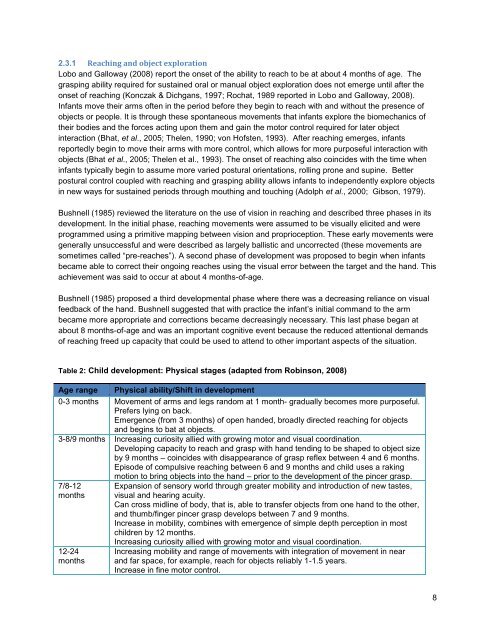Requirements for finger entrapment in European safety ... - ANEC
Requirements for finger entrapment in European safety ... - ANEC
Requirements for finger entrapment in European safety ... - ANEC
You also want an ePaper? Increase the reach of your titles
YUMPU automatically turns print PDFs into web optimized ePapers that Google loves.
2.3.1 Reach<strong>in</strong>g and object exploration<br />
Lobo and Galloway (2008) report the onset of the ability to reach to be at about 4 months of age. The<br />
grasp<strong>in</strong>g ability required <strong>for</strong> susta<strong>in</strong>ed oral or manual object exploration does not emerge until after the<br />
onset of reach<strong>in</strong>g (Konczak & Dichgans, 1997; Rochat, 1989 reported <strong>in</strong> Lobo and Galloway, 2008).<br />
Infants move their arms often <strong>in</strong> the period be<strong>for</strong>e they beg<strong>in</strong> to reach with and without the presence of<br />
objects or people. It is through these spontaneous movements that <strong>in</strong>fants explore the biomechanics of<br />
their bodies and the <strong>for</strong>ces act<strong>in</strong>g upon them and ga<strong>in</strong> the motor control required <strong>for</strong> later object<br />
<strong>in</strong>teraction (Bhat, et al., 2005; Thelen, 1990; von Hofsten, 1993). After reach<strong>in</strong>g emerges, <strong>in</strong>fants<br />
reportedly beg<strong>in</strong> to move their arms with more control, which allows <strong>for</strong> more purposeful <strong>in</strong>teraction with<br />
objects (Bhat et al., 2005; Thelen et al., 1993). The onset of reach<strong>in</strong>g also co<strong>in</strong>cides with the time when<br />
<strong>in</strong>fants typically beg<strong>in</strong> to assume more varied postural orientations, roll<strong>in</strong>g prone and sup<strong>in</strong>e. Better<br />
postural control coupled with reach<strong>in</strong>g and grasp<strong>in</strong>g ability allows <strong>in</strong>fants to <strong>in</strong>dependently explore objects<br />
<strong>in</strong> new ways <strong>for</strong> susta<strong>in</strong>ed periods through mouth<strong>in</strong>g and touch<strong>in</strong>g (Adolph et al., 2000; Gibson, 1979).<br />
Bushnell (1985) reviewed the literature on the use of vision <strong>in</strong> reach<strong>in</strong>g and described three phases <strong>in</strong> its<br />
development. In the <strong>in</strong>itial phase, reach<strong>in</strong>g movements were assumed to be visually elicited and were<br />
programmed us<strong>in</strong>g a primitive mapp<strong>in</strong>g between vision and proprioception. These early movements were<br />
generally unsuccessful and were described as largely ballistic and uncorrected (these movements are<br />
sometimes called “pre-reaches”). A second phase of development was proposed to beg<strong>in</strong> when <strong>in</strong>fants<br />
became able to correct their ongo<strong>in</strong>g reaches us<strong>in</strong>g the visual error between the target and the hand. This<br />
achievement was said to occur at about 4 months-of-age.<br />
Bushnell (1985) proposed a third developmental phase where there was a decreas<strong>in</strong>g reliance on visual<br />
feedback of the hand. Bushnell suggested that with practice the <strong>in</strong>fant’s <strong>in</strong>itial command to the arm<br />
became more appropriate and corrections became decreas<strong>in</strong>gly necessary. This last phase began at<br />
about 8 months-of-age and was an important cognitive event because the reduced attentional demands<br />
of reach<strong>in</strong>g freed up capacity that could be used to attend to other important aspects of the situation.<br />
Table 2: Child development: Physical stages (adapted from Rob<strong>in</strong>son, 2008)<br />
Age range Physical ability/Shift <strong>in</strong> development<br />
0-3 months Movement of arms and legs random at 1 month- gradually becomes more purposeful.<br />
Prefers ly<strong>in</strong>g on back.<br />
Emergence (from 3 months) of open handed, broadly directed reach<strong>in</strong>g <strong>for</strong> objects<br />
and beg<strong>in</strong>s to bat at objects.<br />
3-8/9 months Increas<strong>in</strong>g curiosity allied with grow<strong>in</strong>g motor and visual coord<strong>in</strong>ation.<br />
Develop<strong>in</strong>g capacity to reach and grasp with hand tend<strong>in</strong>g to be shaped to object size<br />
by 9 months – co<strong>in</strong>cides with disappearance of grasp reflex between 4 and 6 months.<br />
Episode of compulsive reach<strong>in</strong>g between 6 and 9 months and child uses a rak<strong>in</strong>g<br />
motion to br<strong>in</strong>g objects <strong>in</strong>to the hand – prior to the development of the p<strong>in</strong>cer grasp.<br />
7/8-12 Expansion of sensory world through greater mobility and <strong>in</strong>troduction of new tastes,<br />
months visual and hear<strong>in</strong>g acuity.<br />
Can cross midl<strong>in</strong>e of body, that is, able to transfer objects from one hand to the other,<br />
and thumb/<strong>f<strong>in</strong>ger</strong> p<strong>in</strong>cer grasp develops between 7 and 9 months.<br />
Increase <strong>in</strong> mobility, comb<strong>in</strong>es with emergence of simple depth perception <strong>in</strong> most<br />
children by 12 months.<br />
12-24<br />
months<br />
Increas<strong>in</strong>g curiosity allied with grow<strong>in</strong>g motor and visual coord<strong>in</strong>ation.<br />
Increas<strong>in</strong>g mobility and range of movements with <strong>in</strong>tegration of movement <strong>in</strong> near<br />
and far space, <strong>for</strong> example, reach <strong>for</strong> objects reliably 1-1.5 years.<br />
Increase <strong>in</strong> f<strong>in</strong>e motor control.<br />
8
















